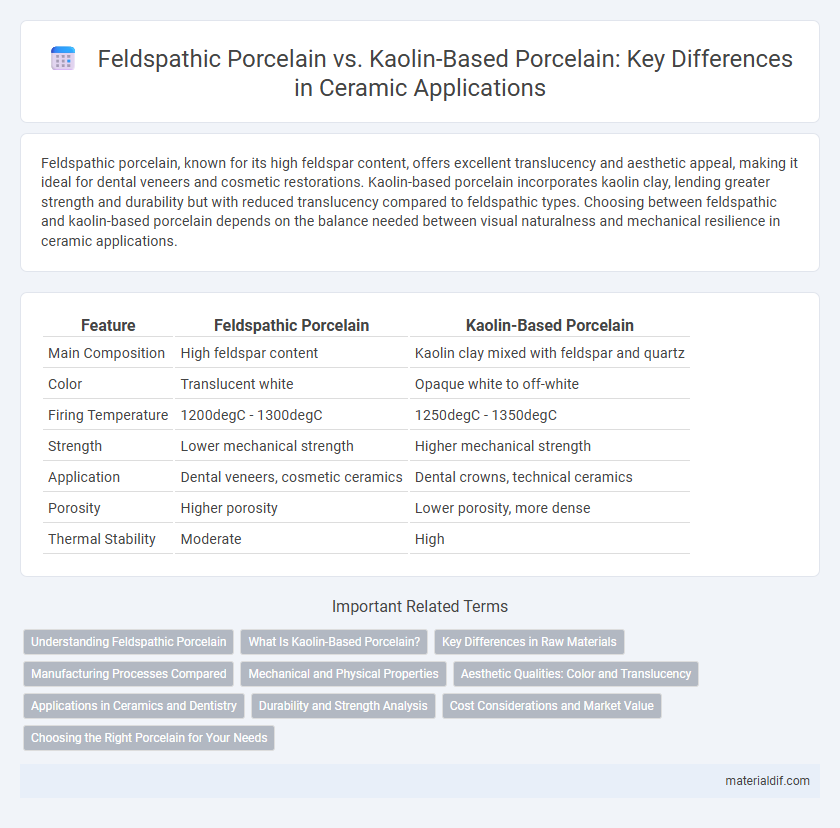Feldspathic porcelain, known for its high feldspar content, offers excellent translucency and aesthetic appeal, making it ideal for dental veneers and cosmetic restorations. Kaolin-based porcelain incorporates kaolin clay, lending greater strength and durability but with reduced translucency compared to feldspathic types. Choosing between feldspathic and kaolin-based porcelain depends on the balance needed between visual naturalness and mechanical resilience in ceramic applications.
Table of Comparison
| Feature | Feldspathic Porcelain | Kaolin-Based Porcelain |
|---|---|---|
| Main Composition | High feldspar content | Kaolin clay mixed with feldspar and quartz |
| Color | Translucent white | Opaque white to off-white |
| Firing Temperature | 1200degC - 1300degC | 1250degC - 1350degC |
| Strength | Lower mechanical strength | Higher mechanical strength |
| Application | Dental veneers, cosmetic ceramics | Dental crowns, technical ceramics |
| Porosity | Higher porosity | Lower porosity, more dense |
| Thermal Stability | Moderate | High |
Understanding Feldspathic Porcelain
Feldspathic porcelain is a type of dental ceramic primarily composed of feldspar minerals, which provide a glassy matrix that enhances translucency and esthetics. This porcelain offers superior esthetic qualities due to its fine particle size and ability to mimic natural tooth enamel, making it ideal for veneers and crowns in restorative dentistry. Its low crystalline content allows for excellent polishability and a lifelike appearance, distinguishing it from the more opaque and stronger kaolin-based porcelains.
What Is Kaolin-Based Porcelain?
Kaolin-based porcelain is a type of ceramic material primarily composed of kaolin clay, which provides exceptional whiteness, translucency, and strength. Its fine particle size and high purity contribute to superior plasticity and firing stability, making it ideal for high-quality porcelain products. This porcelain is often favored for its resistance to thermal shock and mechanical durability compared to feldspathic porcelain.
Key Differences in Raw Materials
Feldspathic porcelain primarily consists of feldspar, quartz, and kaolin, where feldspar acts as a flux to lower the melting temperature during firing. Kaolin-based porcelain contains a higher concentration of kaolin clay, contributing to its increased whiteness and plasticity but requiring higher firing temperatures. The varying proportions of these raw materials significantly influence the mechanical strength, translucency, and firing characteristics of each porcelain type.
Manufacturing Processes Compared
Feldspathic porcelain manufacturing relies on a high percentage of feldspar combined with silica and clay, requiring precise firing temperatures between 1200degC and 1400degC to achieve vitrification and translucency. Kaolin-based porcelain production emphasizes the use of kaolin clay as the primary ingredient, blended with feldspar and quartz, and undergoes a more controlled firing process around 1300degC to 1450degC to enhance whiteness and mechanical strength. The distinct raw material compositions dictate differences in molding, drying, and firing techniques, directly impacting the ceramic's microstructure and final properties.
Mechanical and Physical Properties
Feldspathic porcelain exhibits higher translucency and a lower firing temperature compared to kaolin-based porcelain, making it ideal for aesthetic dental applications but less resistant to mechanical stress. Kaolin-based porcelain contains higher amounts of kaolin clay, resulting in superior strength, increased hardness, and enhanced resistance to thermal shock, which improves its durability in structural and industrial uses. The mechanical properties of feldspathic porcelain include lower flexural strength (approximately 60-70 MPa), whereas kaolin-based porcelain can reach flexural strengths above 100 MPa, reflecting its greater toughness and load-bearing capability.
Aesthetic Qualities: Color and Translucency
Feldspathic porcelain exhibits superior translucency and a warmer color palette, closely mimicking natural tooth enamel, making it highly favored for aesthetic dental restorations. Kaolin-based porcelain tends to have a more opaque appearance with a cooler, whiter shade, resulting from its higher kaolin content that reduces light transmission. The enhanced translucency of feldspathic porcelain allows for more lifelike restorations that blend seamlessly with surrounding teeth, while kaolin-based porcelain provides greater opacity for masking underlying structures.
Applications in Ceramics and Dentistry
Feldspathic porcelain, rich in feldspar minerals, offers superior translucency and aesthetic qualities, making it ideal for dental veneers, crowns, and intricate ceramic artworks. Kaolin-based porcelain contains a higher kaolin clay content, providing enhanced strength and thermal stability, which suits applications like dental crowns requiring durability and industrial ceramic components. In dentistry, feldspathic porcelain is preferred for esthetic anterior restorations, whereas kaolin-based porcelain is favored for posterior crowns due to its mechanical resilience.
Durability and Strength Analysis
Feldspathic porcelain exhibits lower durability and strength due to its higher glass content, making it more prone to chipping and cracking compared to kaolin-based porcelain. Kaolin-based porcelain contains a higher concentration of kaolinite clay, enhancing its mechanical properties, including fracture toughness and flexural strength. The robust microstructure of kaolin porcelain results in superior resistance to wear and thermal shock, ideal for high-stress ceramic applications.
Cost Considerations and Market Value
Feldspathic porcelain generally offers a lower production cost due to the abundance and affordability of feldspar as a raw material, making it a preferred choice in mass-market applications. Kaolin-based porcelain, which incorporates high-purity kaolin clay, commands a higher market value because of its superior strength, translucency, and resistance to thermal shock, appealing to premium and specialized ceramic uses. Understanding these cost and quality trade-offs helps manufacturers and buyers balance budget constraints with desired performance characteristics.
Choosing the Right Porcelain for Your Needs
Feldspathic porcelain offers superior translucency and aesthetic appeal, making it ideal for dental veneers and cosmetic restorations requiring natural appearance. Kaolin-based porcelain provides enhanced strength and durability, suited for crowns and functional prosthetics exposed to higher masticatory forces. Selecting the right porcelain depends on balancing aesthetic requirements with structural demands to ensure longevity and patient satisfaction.
Feldspathic Porcelain vs Kaolin-Based Porcelain Infographic

 materialdif.com
materialdif.com